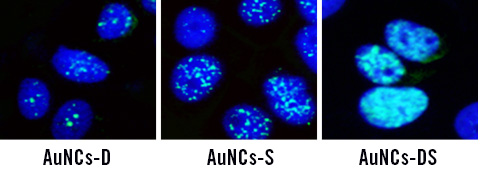Nanotherapy: the controlled delivery of chemotherapeutics to fight cancer stem cells
09.09.2019
 |
|
Increase of the genomic DNA damage (pale blue) mediated by bifunctional (DS) gold nanoclusters (AuNCs) in cancer stem cells. Image: Álvaro Somoza. |
Researchers at IMDEA Nanociencia investigate the efficiency of gold nanoclusters as drug carriers against cancer cells.
Chemotherapy is one of the most used treatments against cancer, together with surgery and radiotherapy. In a chemotherapy treatment, one or several drugs are administered to the patient to remove or damage cancer cells. Nevertheless, the treatment has several drawbacks that are hard to overcome, particularly the side effects. In this case, the inherent toxicity of the drugs employed causes a variety of symptoms including, weakness, nausea and hair loss, placing chemotherapy far from the ideal approach.
In this regard, scientists are trying to improve the efficacy and specificity of chemotherapy using carriers to deliver the drugs only where it is needed. Those based on gold nanostructures are excellent candidates for this objective because of their excellent stability, absence of toxicity and ease of modification with several chemical agents. Furthermore, some gold nanostructures, such as nanoclusters, are fluorescent allowing their use simultaneously for biotracking and imaging purposes.
The group of NanoBiotechnology at IMDEA Nanociencia, led by Prof. Álvaro Somoza, has used gold nanoclusters coated with albumin to facilitate the attachment of two active molecules for the treatment of breast cancer. Particularly, they have used doxorubicin (D), a chemotherapeutic agent that intercalates in the DNA causing cell death, and camptothecin analog SN38 (S), a potent topoisomerase I inhibitor. The modified nanostructures were tested in vitro against breast cancer cells, where the release of chemotherapeutics took place in a controlled manner. Remarkably, the nanotherapy was able to reduce the size and number of mammospheres, a cancer stem cell model. This type of cells present higher resistence to chemotherapy and are responsible for relapses and chemoresistance. What is more, the system combining both drugs presented excellent antitumor activity in different cancer models, thus confirming its promising nanotherapeutic potential.
This is the first time than albumin-stabilized gold nanoclusters have been used to deliver more than one drug, with excellent antitumoral activity, in cancer and cancer stem cells. “Our bifunctional nanostructure could be an excellent solution to overcome the solubility and biodistribution problems of different drugs”, Somoza says. These nanomaterials could be the basis of a Trojan-horse strategy to get the chemotherapeutics effectively inside the tumours. The gold nanoclusters act as the vehicles for carrying the drugs where is needed and release them upon internal stimuli. Whereas chemotherapy research is developing new drugs for cancer treatment, emerging nanotherapies are about building smart vehicles for existing drugs, reducing costs and improving the efficiency of the treatments.
This work is a collaboration between research groups at IMDEA Nanociencia, the Autonomous University of Madrid and the Center for Biological Research (CIB-CSIC). It has been partially funded by the Spanish Ministry for Science, Innovation and Universities, the Regional Government of Comunidad de Madrid, the Spanish Association Against Cancer and the Centre of Excellence Severo Ochoa recognition to IMDEA Nanociencia (2017-2021).
Reference:
A. Latorre, A Latorre et al. Multifunctional albumin-stabilized gold nanoclusters for the reduction of cancer stem cells. Cancers 11, 969 (2019).
Contact
Dr. Álvaro Somoza
alvaro.somoza [at]imdea.org
http://nanociencia.imdea.org/nanobiotechnology/group-home
Twitter: @alvarosomoza
Oficina de Comunicación Científica de IMDEA Nanociencia
This email address is being protected from spambots. You need JavaScript enabled to view it.
91 299 87 12
Twitter: @imdea_nano
Facebook: @imdeananociencia
Source: IMDEA Nanociencia




